This week EFSP brings a tribute to Ross Verlag. The German publishing company produced many, many star postcards from the late 1910s till the early 1940s. Ross Verlag, which can be translated as Ross Publishers, was named after the founder, Heinrich Ross. Today we start with a post with 20 sepia-tinted postcards from Ross' early years, all portraying European stars of the silent cinema.
![Ally Kolberg]()
Ally Kolberg. German postcard by Ross Verlag, Berlin, no. 253, 1919-1924. Photo: Ernst Schneider.
![Fern Andra]()
Fern Andra. German postcard by Ross Verlag, no. 289/3. Photo: Fern Andra Atelier. Although most Ross postcards have a white border around the photos, some have no border, or a much narrower one.
![Ossi Oswalda and Hermann Thimig in Die Puppe]()
German postcard by Ross Verlag, Berlin, no. 635/5, 1919-1924. Photo: Union. Publicity still for Die Puppe/The Doll (Ernst Lubitsch, 1919) with Ossi Oswalda and Hermann Thimig.
![Pola Negri and Harry Liedtke in Madame DuBarry (1919)]()
German postcard by Ross Verlag, Berlin, no. 627/2, 1919-1924. Photo: Union. Publicity still for Madame DuBarry (Ernst Lubitsch, 1919) with Pola Negri and Harry Liedtke.
![Henny Porten in Der Kaufmann von Venedig]()
German postcard by Ross Verlag, no. 658/4. Photo: Peter Paul Felner-Film Co. Publicity still for Der Kaufmann von Venedig/The Merchant of Venice (Peter Paul Felner, 1923) with Henny Porten.
The founder of Ross Verlag, Heinrich Ross, was born in 1870 in Rokytno, Austria-Hungary, now a part of the Czech-Republic.
Sometime around 1905-1907, he began to work at the Rotophot postcard publishing company in Berlin. Rotophot had started around the turn of the century (1900) and had other offices throughout Europe, including London and Budapest.
In 1919, Heinrich founded the postcard company that bore his name, Ross Verlag. Originally, Ross operated as a distributor of postcards, but soon became a publisher (verlag).
After Adolph Hitler came into power in 1933, the persecution of the Jews in Germany began. By 1937, Ross Verlag was no longer in its Jewish founder's control.
Heinrich Ross was forced out by the National Socialists through their Arisierung (Aryanization) program (no Jews could own a business.) Interestingly enough, they retained the Ross Verlag name until 1941.
Ross boarded the passenger ship the S.S. St. Louis in Hamburg, Germany on 13 May 1939. The ship was bound for Cuba with 937 passengers, most of them German Jews. When they arrived at their destination, the Cuban government refused to allow the passengers to disembark.
After many unsuccessful attempts, they next tried to dock in the USA. The United States government also refused them entry into the country. Both countries had immigration quotas that had already been filled. Having nowhere else to go, the St. Louis and it's passengers were forced to head back to Europe.
Ross was allowed passage to England as refugee. Heinrich spent three years in England, bu in 1942 he boarded the passenger ship the S.S. Pacific Enterprise and crossed the Atlantic to America. He could join his family in New York.
Heinrich had lost his fortune through Nazi confiscation, paying a 'flight tax' to leave, as well as the payment of his ship's passage. Reportedly, at the age of 73, Heinrich started working again in a machine shop in Chicago, up to the age of 84.
In 1956, he and his son received compensation from Germany for the loss of their Berlin company in the amount of 50,000 Deutsche Marks. In 1957, at the age of 86, Heinrich Ross passed away at the Michael Reese Hospital in Chicago, Illinois of a stroke and pneumonia.
![Conrad Veidt in Das indische Grabmal]()
German postcard by Ross Verlag, no. 539/1. Photo: May Film. Conrad Veidt as the proud and cruel Maharajah of Eschnapur in the two-part monumental film Das indische Grabmal/ The Indian Tomb (Joe May, 1921-1922).
![Die Nibelungen 1: Siegfried]()
German postcard by Ross Verlag, Berlin, no. 673/2, 1919-1924. Photo: Decla-Ufa-Film. Publicity still for Die Nibelungen: Siegfried (Fritz Lang, 1924). Siegfried (Paul Richter) in the forest.
![Henny Porten in Mutter und Kind (1924).]()
German postcard by Ross Verlag, no. 682/3. Photo: FFG (Froehlich-Flm GmbH). Henny Porten in Mutter und Kind/Mother and Child (Carl Froehlich, 1924), co-starring Wilhelm (later William) Dieterle.
![Carlo Aldini]()
German postcard by Ross Verlag, no. 858/4. Photo: Phoebus Film / Rembrandt. Italian actor Carlo Aldiniimitating Myron's discus thrower.
![Brigitte Helm in Metropolis]()
German postcard by Ross Verlag, Berlin, no. 71/12. Photo: Ufa / Parufamet. Publicity still for Metropolis (Fritz Lang, 1927), starring Brigitte Helm. Collection: Didier Hanson.
The familiar Ross Verlag logo first appeared in the early 1920s. On the front of the card were the words: Verlag "Ross" Berlin SW68. SW stands for Southwest and 68 is an area code in that region of Berlin.
Mark Goffee: "Ross Verlag printed real photo postcards of the highest quality, among the finest ever published of movie stars. The company licensed thousands of images from the Hollywood studios; some of those photos may have only been distributed on these postcards. In Germany, movie stars were photographed by the best European glamour studios. Quite possibly, many of these photos were taken just for publication through Ross Verlag."
The majority of the Ross Verlag cards are numbered and the numbers went up to 9997/1 and then started over again with the letter "A". These cards began at A 1000 and continue to around A 4096.
The numbering system includes a series number, then a slash followed by a card number (for example: 3112/2). The card numbers of a specific series would be of one particular actress or group of actors or a film (for example, 1028/1, 1028/2, 1028/3 and 1028/4 all show actress Lya de Putti).
Usually a set of cards of one or more actors would be from the same film (although not always) or photographer. Around card number 1930/1 (in the year 1928), the Verlag "Ross" Berlin SW68 on the cards changed to simply "Ross" Verlag.
Ross Verlag seemed to disappear by the end of the war, but the Film-Foto-Verlagname did reappear in the early to mid 1950s for a short while. It soon changed to UFA/Film-Foto. Whether this company had any links to the original Ross is unknown.
![Asta Nielsen]()
Asta Nielsen. German postcard by Ross Verlag, no. 580/3, 1919-1924. Photo: Art Film.
![Maria Paudler and Ernst Verebes in Der Bettelstudent (1927)]()
German postcard by Ross Verlag, no. 91/4. Photo: Aafa Film. Publicity still for Der Bettelstudent/The Beggar Student (Jacob Fleck, Luise Fleck, 1927) with Maria Paudler and Ernst Verebes.
![Lya Mara, An der schöne blauen Donau]()
German postcard by Ross Verlag, no. 56/3, 1925-1926. Photo: Zelnik Film. Publicity still for An der schönen blauen Donau/The Beautiful Blue Danube (Friedrich Zelnik, 1926), starring Lya Mara. Collection: Egbert Barten.
![Willy Fritsch in Ungarische Rhapsodie]()
German postcard by Ross Verlag, no. 104/2. Photo: Ufa. Publicity still for Ungarische Rhapsodie/Hungarian Rhapsody (Hanns Schwarz, 1928) with Willy Fritsch.
![Liane Haid]()
Liane Haid. German postcard by Ross Verlag, no. 1075/2, 1927-1928. Photo: Alex Binder
On his website Ross Verlag Movie Star Postcards, Mark Goffee tells the company's history, and he created checklists of the Ross postcards.
For EFSP, we use these lists quite often, e.g. for the dating of our Ross postcards. But there is much more to discover on the Ross Verlag Movie Star Postcards site.
Goffee presents many postcards from his own collection, and he gives a lot of facts and feats.There are for example heart shaped photos on certain Ross cards, and opera stars appeared on Ross cards in roles they were famous for.
The website also presents bloopers: a few mistakes that were made on the cards, and it shows that some cards were actually drawings.
Goffee offers at his website many interesting links. Check it out! And tomorrow at EFSP, we present 20 of our favourite Ross Verlag postcards with Hollywood stars of the 1920s.
![Hanni Weisse]()
Hanni Weisse. German postcard by Ross Verlag, no. 1383/1, 1927-1928. Photo: Fox. Some postcards with smaller 'framed' oval photos contained an autographed message from the actor, usually related to art, or some witticism
![Maly Delschaft]()
Maly Delschaft. German postcard by Ross Verlag, no. 3653/1, 1928-1929. Photo: Atelier Manassé, Wien.
![Rina de Liguoro]()
Rina de Liguoro. German postcard by Ross Verlag, no. 3902/1, 1928-1929. Photo: Pinto Roma. There were several Ross postcards with oval photos, although this format didn't last too long.
![Iwan Mosjukin]()
Ivan Mozzhukhin. German postcard by Ross Verlag, no. 3948/1, 1928-1929. Photo: Ufa.
![Gustav Diessl in Die weiße Hölle vom Piz Palü (1929)]()
Gustav Diessl. German postcard by Ross Verlag, no. 4485/2, 1929-1930. Photo: Hans Casparius, Berlin. Publicity still for Die weiße Hölle vom Piz Palü/The White Hell of Pitz Palu (Arnold Fanck, G.W. Pabst, 1929).
Source: Mark Goffee (Ross Verlag Movie Star Postcards).
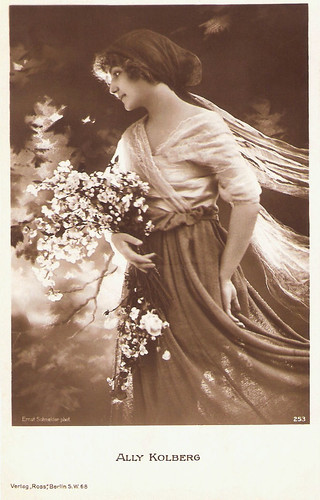
Ally Kolberg. German postcard by Ross Verlag, Berlin, no. 253, 1919-1924. Photo: Ernst Schneider.

Fern Andra. German postcard by Ross Verlag, no. 289/3. Photo: Fern Andra Atelier. Although most Ross postcards have a white border around the photos, some have no border, or a much narrower one.
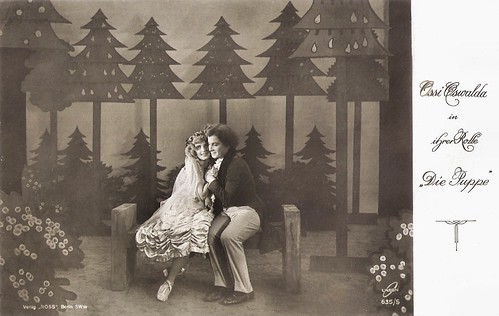
German postcard by Ross Verlag, Berlin, no. 635/5, 1919-1924. Photo: Union. Publicity still for Die Puppe/The Doll (Ernst Lubitsch, 1919) with Ossi Oswalda and Hermann Thimig.
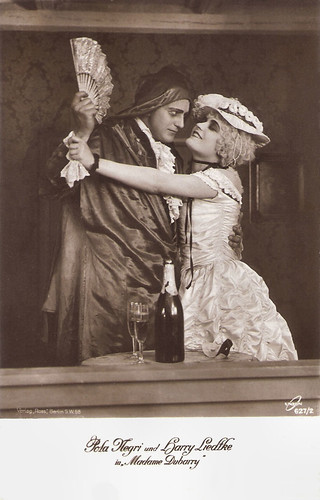
German postcard by Ross Verlag, Berlin, no. 627/2, 1919-1924. Photo: Union. Publicity still for Madame DuBarry (Ernst Lubitsch, 1919) with Pola Negri and Harry Liedtke.

German postcard by Ross Verlag, no. 658/4. Photo: Peter Paul Felner-Film Co. Publicity still for Der Kaufmann von Venedig/The Merchant of Venice (Peter Paul Felner, 1923) with Henny Porten.
Heinrich Ross
The founder of Ross Verlag, Heinrich Ross, was born in 1870 in Rokytno, Austria-Hungary, now a part of the Czech-Republic.
Sometime around 1905-1907, he began to work at the Rotophot postcard publishing company in Berlin. Rotophot had started around the turn of the century (1900) and had other offices throughout Europe, including London and Budapest.
In 1919, Heinrich founded the postcard company that bore his name, Ross Verlag. Originally, Ross operated as a distributor of postcards, but soon became a publisher (verlag).
After Adolph Hitler came into power in 1933, the persecution of the Jews in Germany began. By 1937, Ross Verlag was no longer in its Jewish founder's control.
Heinrich Ross was forced out by the National Socialists through their Arisierung (Aryanization) program (no Jews could own a business.) Interestingly enough, they retained the Ross Verlag name until 1941.
Ross boarded the passenger ship the S.S. St. Louis in Hamburg, Germany on 13 May 1939. The ship was bound for Cuba with 937 passengers, most of them German Jews. When they arrived at their destination, the Cuban government refused to allow the passengers to disembark.
After many unsuccessful attempts, they next tried to dock in the USA. The United States government also refused them entry into the country. Both countries had immigration quotas that had already been filled. Having nowhere else to go, the St. Louis and it's passengers were forced to head back to Europe.
Ross was allowed passage to England as refugee. Heinrich spent three years in England, bu in 1942 he boarded the passenger ship the S.S. Pacific Enterprise and crossed the Atlantic to America. He could join his family in New York.
Heinrich had lost his fortune through Nazi confiscation, paying a 'flight tax' to leave, as well as the payment of his ship's passage. Reportedly, at the age of 73, Heinrich started working again in a machine shop in Chicago, up to the age of 84.
In 1956, he and his son received compensation from Germany for the loss of their Berlin company in the amount of 50,000 Deutsche Marks. In 1957, at the age of 86, Heinrich Ross passed away at the Michael Reese Hospital in Chicago, Illinois of a stroke and pneumonia.

German postcard by Ross Verlag, no. 539/1. Photo: May Film. Conrad Veidt as the proud and cruel Maharajah of Eschnapur in the two-part monumental film Das indische Grabmal/ The Indian Tomb (Joe May, 1921-1922).
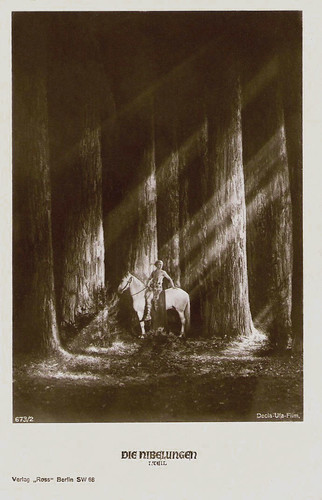
German postcard by Ross Verlag, Berlin, no. 673/2, 1919-1924. Photo: Decla-Ufa-Film. Publicity still for Die Nibelungen: Siegfried (Fritz Lang, 1924). Siegfried (Paul Richter) in the forest.

German postcard by Ross Verlag, no. 682/3. Photo: FFG (Froehlich-Flm GmbH). Henny Porten in Mutter und Kind/Mother and Child (Carl Froehlich, 1924), co-starring Wilhelm (later William) Dieterle.
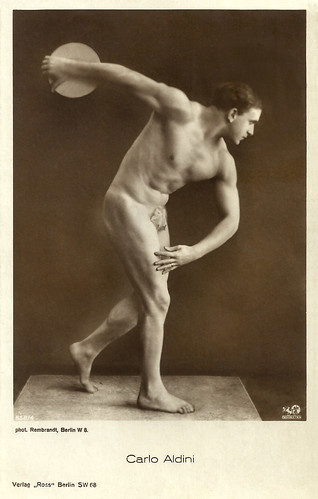
German postcard by Ross Verlag, no. 858/4. Photo: Phoebus Film / Rembrandt. Italian actor Carlo Aldiniimitating Myron's discus thrower.

German postcard by Ross Verlag, Berlin, no. 71/12. Photo: Ufa / Parufamet. Publicity still for Metropolis (Fritz Lang, 1927), starring Brigitte Helm. Collection: Didier Hanson.
Ross Verlag
The familiar Ross Verlag logo first appeared in the early 1920s. On the front of the card were the words: Verlag "Ross" Berlin SW68. SW stands for Southwest and 68 is an area code in that region of Berlin.
Mark Goffee: "Ross Verlag printed real photo postcards of the highest quality, among the finest ever published of movie stars. The company licensed thousands of images from the Hollywood studios; some of those photos may have only been distributed on these postcards. In Germany, movie stars were photographed by the best European glamour studios. Quite possibly, many of these photos were taken just for publication through Ross Verlag."
The majority of the Ross Verlag cards are numbered and the numbers went up to 9997/1 and then started over again with the letter "A". These cards began at A 1000 and continue to around A 4096.
The numbering system includes a series number, then a slash followed by a card number (for example: 3112/2). The card numbers of a specific series would be of one particular actress or group of actors or a film (for example, 1028/1, 1028/2, 1028/3 and 1028/4 all show actress Lya de Putti).
Usually a set of cards of one or more actors would be from the same film (although not always) or photographer. Around card number 1930/1 (in the year 1928), the Verlag "Ross" Berlin SW68 on the cards changed to simply "Ross" Verlag.
Ross Verlag seemed to disappear by the end of the war, but the Film-Foto-Verlagname did reappear in the early to mid 1950s for a short while. It soon changed to UFA/Film-Foto. Whether this company had any links to the original Ross is unknown.

Asta Nielsen. German postcard by Ross Verlag, no. 580/3, 1919-1924. Photo: Art Film.

German postcard by Ross Verlag, no. 91/4. Photo: Aafa Film. Publicity still for Der Bettelstudent/The Beggar Student (Jacob Fleck, Luise Fleck, 1927) with Maria Paudler and Ernst Verebes.

German postcard by Ross Verlag, no. 56/3, 1925-1926. Photo: Zelnik Film. Publicity still for An der schönen blauen Donau/The Beautiful Blue Danube (Friedrich Zelnik, 1926), starring Lya Mara. Collection: Egbert Barten.

German postcard by Ross Verlag, no. 104/2. Photo: Ufa. Publicity still for Ungarische Rhapsodie/Hungarian Rhapsody (Hanns Schwarz, 1928) with Willy Fritsch.

Liane Haid. German postcard by Ross Verlag, no. 1075/2, 1927-1928. Photo: Alex Binder
Mark Goffee
On his website Ross Verlag Movie Star Postcards, Mark Goffee tells the company's history, and he created checklists of the Ross postcards.
For EFSP, we use these lists quite often, e.g. for the dating of our Ross postcards. But there is much more to discover on the Ross Verlag Movie Star Postcards site.
Goffee presents many postcards from his own collection, and he gives a lot of facts and feats.There are for example heart shaped photos on certain Ross cards, and opera stars appeared on Ross cards in roles they were famous for.
The website also presents bloopers: a few mistakes that were made on the cards, and it shows that some cards were actually drawings.
Goffee offers at his website many interesting links. Check it out! And tomorrow at EFSP, we present 20 of our favourite Ross Verlag postcards with Hollywood stars of the 1920s.

Hanni Weisse. German postcard by Ross Verlag, no. 1383/1, 1927-1928. Photo: Fox. Some postcards with smaller 'framed' oval photos contained an autographed message from the actor, usually related to art, or some witticism

Maly Delschaft. German postcard by Ross Verlag, no. 3653/1, 1928-1929. Photo: Atelier Manassé, Wien.

Rina de Liguoro. German postcard by Ross Verlag, no. 3902/1, 1928-1929. Photo: Pinto Roma. There were several Ross postcards with oval photos, although this format didn't last too long.

Ivan Mozzhukhin. German postcard by Ross Verlag, no. 3948/1, 1928-1929. Photo: Ufa.

Gustav Diessl. German postcard by Ross Verlag, no. 4485/2, 1929-1930. Photo: Hans Casparius, Berlin. Publicity still for Die weiße Hölle vom Piz Palü/The White Hell of Pitz Palu (Arnold Fanck, G.W. Pabst, 1929).
Source: Mark Goffee (Ross Verlag Movie Star Postcards).